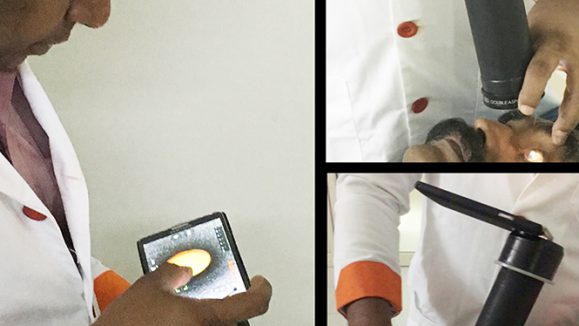While researchers and innovations are ongoing, doctors grapple with the day-to-day realities of dealing with patients and their responses to treatment. Current issues in safety and efficacy of pharmaceuticals — as well as the latest innovations in gene therapy — and the potential options available for patients, were discussed among a panel of experienced clinical practitioners, at the recently held OIS Retina Innovation Showcase.
The panel included Dr. Allen Ho, attending surgeon and director of retina research at Wills’ Eye Hospital (PA, USA); Dr. Peter Kaiser, professor of ophthalmology at Cole Eye Institute (OH, USA); Dr. Christina Weng, assistant professor of ophthalmology at Baylor College of Medicine (TX, USA); and Dr. Marco Zarbin, chair and professor at Institute of Ophthalmology and Visual Science at Rutgers Medical School (NJ, USA). The session was moderated by Dr. John Pollack, assistant professor of ophthalmology at Rush University Medical Center in Chicago (USA).
Brolucizumab on Spotlight
Brolucizumab has faced unexpected issues after its October 2019 approval. It had strong phase 3 HAWK and HARRIER studies, which showed non-inferior vision outcomes and superior drying effect compared to aflibercept — with over 50% of patients maintaining 12-weekly dosing through 48 weeks. It then hit a speed bump when the American Society of Retinal Specialists (ASRS) Research and Safety in Therapeutics Committee (ReST) began receiving reports of severe vision loss related to occlusive vasculitis following some brolucizumab injections, something not seen in existing anti-VEGF agents.
Parallel to the committee’s analysis, Novartis called for an independent Safety Review Committee to evaluate the reports of inflammation and to critically review the phase 3 data from HAWK and HARRIER. The Novartis-appointed committee found a 1:200 risk of more than 6 lines of vision acuity loss due to occlusive vasculitis for all brolucizumab patients. Onset of inflammation could be seen as far out as 18 months after initiation of the treatment, but the majority of cases had onset within less than 6 months. Despite these issues, the overall vision outcomes in HAWK and HARRIER were non-inferior to aflibercept, with an overall rate of ≥3-line vision loss (7.4% and 7.7% for brolucizumab and aflibercept, respectively).
The panel was asked if they agreed that this was a “737 Max” moment for brolucizumab with Drs. Philip Rosenfeld and David Browning urging for a moratorium on its use in a recent editorial in the American Journal of Ophthalmology.
Dr. Kaiser said, “At the end of the day, I have patients who still use this drug and patients on whom it works very well. And sort of all lost in this is that this is an incredibly drying agent.
“This is not something like 737 Max where we retrain the pilots. Rather we have to fly the plane at the same time. We need to use this drug in patients who need it,” he said, adding that doctors have a choice to stop using it and that it’s a shared decision between doctor and patient.
Dr. Zarbin said he won’t use brolucizumab as his first choice and would only consider it if other drugs don’t seem to work on the patient. He added that if steroid therapy is used early enough, it might mitigate the issue.
What about Faricimab and Ranibizumab PDS in nAMD?
The next topic discussed was faricimab in nAMD related to the Stairway phase 2 results in the DSRS, which show acuity gains based on a 16-week flex dosing. If the phase 3 outcomes are similar to phase 2 — and it was compared to a monthly dosing with the control group — could this become a firstline therapy?
”I think the results are really promising with faricimab. First of all, it’s our first dual mechanism drug and people are really excited about the fact that it works in a slightly different way from what our current agents have to offer. The efficacy was really impressive in the phase 2 study — that it went up against what we consider as gold standards like ranibizumab, and there were similar acuity outcomes. Many patients only needed about half the amount of injections,” Dr. Weng said, adding faricimab also showed excellent safety and could have a spot in the market share if it is launched.
They also discussed the primary analysis results of the phase 3 Archway trial of the port delivery system (PDS) with ranibizumab for nAMD patients (presented by Dr. Peter Campochiaro at the recent ASRS 2020 virtual meeting).
Dr. Pollack said considering that the PDS was shown to maintain vision while reducing treatment burden through continuous delivery of anti-VEGF. If FDA approved and with a reasonable safety profile, which patients would doctors consider switching from injections to implants?
Dr. Zarbin said he would, firstly, consider people who are surgical candidates and those who want to reduce their frequency of injections and demonstrate that they were anti-VEGF responsive. “Peter [Dr. Campochiaro] made an important point about the issue of macular atrophy. One good thing about the PDS is you could always take it out, unlike gene therapy.”
However, he highlighted the 5% complication incidence (i.e., endophthalmitis, retinal detachment) which is quite a concern. Dr. Kaiser said he agreed with Dr. Zarbin and he would not use this therapy on treatment-naive patients, as well as those most likely not to show up at his office should they face any complications.
Dr. Ho said the PDS would have a place in patients with AMD. If they could get home monitoring programs going for safety, this might be a more durable form of treatment.

Medical retina experts discussed the pros and cons of various anti-VEGF agents based on clinical trial data and safety outcomes.
The Role of Gene Therapy in nAMD
Gene therapy was also discussed when Dr. Pollack cited the ADVM-022 intravitreal gene therapy for nAMD (OPTIC Trial Cohorts 1-3). In phase 1 of this study, there was reduced dependence on topical steroids (17%), with the lower concentration dosing and rescue-free rate of 80% at a 20-week time point. However, the long-term use of steroids could face barriers in uptake, due to things like patient burden and continued monitoring and management.
Dr. Weng said steroids are for patients who have persistent fluids and who are on monthly injections. She said steroid drops can cause long-term progression of cataracts, increased IOP, as well as being a cost and lifestyle burden for patients. Also, patients aren’t very compliant with drops.
Dr. Ho brought up the challenge of monitoring inflammation when using steroids as a long-term therapy of 6 months or longer. “The cohort 4’s results will be pivotal and we’ll see what the data shows,” he said.
The next discussion was on the RGX-314 phase 1/2a nAMD trial dose escalation protocol. The question looked at balancing the pros of immune-privileged space borne out of not needing long-term steroid therapy, versus it being a surgical procedure in the subretinal approach.
Dr. Ho said compared with Adverum’s study, Adverum’s situation still saw some inflammation which could be controlled with topical drugs, and Regenxbio’s innovation was quite impressive with no inflammation. “Suprachoroidal [delivery] has certain big advantages because you don’t have to go to the operating room. On the other hand, if this were safe, patients who have a high burden of treatment would consider a single surgical procedure,” he said.
”There’s strong pre-clinical data indicating that the immune suppressant environment in subretinal space is actually stronger than in the vitreal cavity. So I’m not at all surprised to see the difference in immune-inflammatory response of the two approaches,” Dr. Zarbin said.
“I think intravitreal suprachoroidal is going to beat the pants off the subretinal injection assuming they have the same safety and efficacy,” he added.
The last two studies discussed were Iveric’s GATHER 1, where they discussed the study’s geography atrophy (GA) rate by inhibiting the C5 protein pathway and its higher rate of CNV as potential barriers.
Of CNVs, GAs and Retinitis Pigmentosa
“What would the curve need to look like? I think we’ll take anything at this point because we don’t have anything [for GA] and because patients will endure this kind of treatment, we shall see,” said Dr. Ho.
Dr. Zarbin quipped that “a group of people for whom this therapy might help would be those who are actually getting injections for choroidal neovascularization (CNV) and who have atrophy because I’m convinced for whatever reason, they’re getting visual loss because of that, even if they’re dry.”
Lastly, the panel presented their impression of retinal progenitor cell therapy and their thoughts on the trial results presented by jCyte’s intravitreal injection of allogeneic human retinal progenitor cells (jCells) for treatment of retinitis pigmentosa in their phase 2b trial.
Dr. Zarbin reminded everyone that it’s basically a neurotrophic therapy and not a cell replacement therapy. “The remarkable thing is, it is administered as an intravitreal injection and requires no immunosuppression whatsoever . . . so those are very attractive features,” he said, adding he will watch to see this trial’s phase 3 data.
Drs. Weng and Kaiser expressed their hope that this innovative approach of treating RP, for which there are very few other options for now.

“All these approaches are reflective of our patients’ good fortune, and that’s why we’re having this meeting . . . the ecosystem of science, drive, innovation, profit and business, and quality of life makes this a unique space. To have multiple batters to come to the plate to strike out, and for the third batter and fourth hit a double, we’ll see if we get a home run,” Dr. Ho said.
Cuts Both Ways and More, with Precision
Meanwhile, Alcon’s single-minded focus on ophthalmic devices has seen the launch of the world’s fastest cut rate pneumatic vitrectomy probe in the past year.
The HyperVit® has the capability to perform 20,000 cuts per minute, thanks to its dual-blade design which cuts twice in each cycle. This minimizes vitreous traction on the retina.
“Stability and control are improved during microincision vitrectomy surgeries (MIVS), while there’s reduction in fluidic turbulence in the eye,” said Paul Hallen, VP and global head of retina and glaucoma at Alcon. “The flow rates are also improved significantly as the dual port facilitates ‘continuous flow’ because one port is always open.”
The Hypervit® bevel-tipped vit probe provides 40% closer access to vitreous and membranes close to the retina. Mr. Hallen said the traditional “square edge” vit probe makes no sense when used on the retina, which is a hemisphere.
Another innovation is their reflex instrument — the Grieshaber® DSP Instrumentation series — which has revolutionized retina surgery with instruments like its Finesse® Sharkskin™ ILM Forceps. Its microtextured surface and larger platform is designed for precision grasping during ILM peeling, while the Finesse® Flex Loop has a unique Nitinol Loop designed for consistency when creating an ILM edge.
Editor’s Note: OIS Retina Showcase, organized by Ophthalmology Innovation Source (OIS) was held on September 10. This high-impact program delivered a retina market overview, presentations and panel discussions with KOLs and industry executives.



